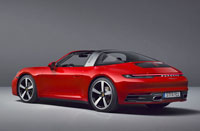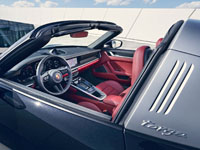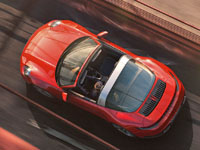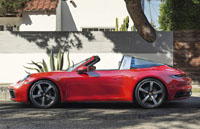
The all-new 911 (992) Coupe and Cabriolet have been with us for much of the year now, with various trims including the Carrera, Carrera S, Carrera 4, Carrera 4S and Turbo S trickling out of Porsche’s Baden-Württemberg, Stuttgart assembly plant since inception, and now that the redesigned Targa is here the 911 family is complete.
OK, GTS models have yet to arrive, but at least all 911 body styles are accounted for, until the automaker makes a Speedster variant that is. The Targa first arrived at the 1965 Frankfurt Motor Show before showing up in production trim for the 1967 model year, this first convertible 911 designed with a roll hoop behind driver and passenger to meet expected U.S. safety regulations that never materialized.
Along with the stainless steel covered roll bar, the first Targa featured a removable rear window made from plastic, this replaced with fixed rear glass window the following year, while the Targa’s roof design has been modified dramatically over the years. While the roll hoop sometimes came in black instead of silver, the first model had a removable roof panel ahead of the 1996–1998 993 model that came out with a power-sliding glass roof that automatically stowed below the rear window. The update, which carried over to the 2006–2012 997, completely overhauled the Targa’s look with sweptback C pillars and sharply angled rear quarter windows.

The 2016–2019 991.2 Targa said goodbye to the big powered sunroof and hello to a power-retractable hardtop-style roof mechanism that hoisted the entire rear deck lid ahead of storing the roof panel underneath. This new roof design allowed Porsche to return to the original silver roll hoop styling too, and thankfully this more technical approach continues forward into the new 2021 911 Targa. While the roof mechanism is a highly sophisticated bit of kit, it only takes 19 seconds to lower or raise, so therefore it can easily be done while waiting at a stoplight.
Everything under the new Targa’s beltline is mostly the latest 992-generation Carrera Coupe/Convertible design, which means that the new hood and lower front fascia eliminate the outgoing 911’s body-colour ovoid shapes and add straighter, more horizontal lines, highlighted by a big, black rectangular front vent that first catches the eye. This gives the new model a wider, more aggressive stance, whereas the sharply angled hood features classic tapered creases at each side of its indented centre, much like the original 911’s hood, but without the vented end. Porsche’s ovoid multi-element four-point LED headlight clusters are almost identical to the outgoing car, which will a positive to anyone still fearing the days of the much-lambasted 996.

The three vertical indentations on the new Targa’s B pillars, and the classic scripted “targa” nameplate and silver colour treatment, help 991 and 992 model profiles initially look the same. Inspecting the new car’s design more closely, however, in fact reveals front and rear fascias wrapping farther around the side bodywork, plus fractionally more upright headlights, tail lamps that extend forward much like the rear bumper vents, reworked front side marker lights, new flat-bezeled wheel cutouts, an updated set of mirror housings, special flush-mounted exterior door handles that extend outward when touched (replacing the outgoing model’s more traditionally rounded door pulls), and a smoother rear deck lid, all resulting a fresh new take on the classic 911 Targa’s design.
Those tail lamps come into clearer view when seen from behind, with the new model expanding on the outgoing 991’s slim, dagger-like LED-enhanced lenses and even narrower body-wide light strip by reach farther outward to each side, plus grafting on some 718-like 3D-like graphics at the centre lighting position, these sitting over seemingly open vent slats underneath, while carving out even an more linear design for the outer taillights.

Just like the new Carrera, the updated Targa’s diffuser-enhanced lower rear bumper is larger, blacker, and beefier looking than previously, while it also feeds the engine’s exhaust pipes from within instead of forcing them to exit below. Additionally, hidden under the new 911’s flowing rear deck lid and just over the aforementioned light strip, which sits below a row of gloss-black engine vent strakes, is a wider and larger active spoiler boasting multiple positions depending on variable levels of rear downforce.
The new 911 Targa’s bumpers aside, all body panels are now formed out of lightweight aluminum, whereas the front fenders and underlying body structure were lightened substantially, the latter more than halving its steel content from 63 to 30 percent. The 70 percent left over is now wholly constructed from aluminum, all of which helps to improve structural rigidity, handling, and fuel-efficiency.
New standard Targa 4 wheels measure 19 inches up front and 20 inches at the rear, with the former shod in 235/40 ZR-rated performance rubber and the latter wearing a wider set of 295/35 ZRs, whereas the Targa 4S gets a staggered set of 20- and 21-inch alloy wheels wrapped in 245/35 ZR and 305/30 ZR tires respectively.

As with the new Carreras and Turbos that arrived before, the latest Targa comes with an interior that was inspired by 911 models from the 1960s, 1970s, 1980s and even the 1990s, especially regarding the wide, horizontal dash layout to the right of the traditional arcing instrument hood. The former even incorporates a narrow shelf that mimics the lower edge of the original model’s dashboard, but that’s about it when it comes to mirroring Porsche’s past 911 cabins.
The new Targa’s electronic interfaces immediately set it apart as a state-of-the-art machine, its instrument cluster mostly digital other than housing an analogue tachometer at centre. With the ignition on the new 911 Targa follows Porsche tradition thanks to a five-dial layout, although the left TFT/LCD display incorporates a conventional-style speedometer in default mode, or alternatively the car’s new advanced driver assistance systems that include adaptive cruise control, blind spot warning, lane keeping assist, etcetera, whereas the right-side screen features a multi-information display with route guidance, audio, trip, cruise control info and more.
The just-noted horizontal dash design incorporates a big 10.9-inch high-definition Porsche Communication Management (PCM) infotainment touchscreen, which is 3.9 inch larger than the previously car’s centre display. It boasts much greater depth of colour too, plus new graphics, better performance, and additional features from fewer analogue switches.

As with the previous 911 Targa, the new 2021 version will initially ship in 4 and 4S trims, while a Targa 4 GTS will arrive later. The base Targa 4 includes Porsche’s 3.0-litre twin-turbocharged, horizontally opposed six-cylinder engine that’s good for 379 horsepower and 332 lb-ft of torque. It comes mated to a standard eight-speed PDK automated transmission with steering wheel paddles (the new autobox gets one more forward gear compared to the outgoing Targa’s seven-speed PDK), which results in a scant 4.4-second sprint from zero to 100 km/h in base trim or 4.2 seconds from standstill to 100 km/h with its Sport Chrono Package upgrade.
Porsche makes a seven-speed manual transmission available when opting for the Sport Chrono Package in the new 911 Targa 4S, which when combined with this model’s more potent 443 horsepower 3.0-litre six putting out 390 lb-ft of torque only matches the less powerful Targa 4’s 4.4-second sprint to 100 km/h, this because of the base Targa’s more efficient standard PDK gearbox. This said, when the more formidable engine is synched up to the dual-clutch automated PDK it can manage a much more entertaining 3.8-second zero to 100 km/h sprint in its base trim or 3.6 seconds to the same mark with the Sport Chrono Package.
As with the new all-wheel drive Carrera 4 and 4S that launched earlier, both Targa 4 and 4S models use a unique water-cooled front differential that features reinforced clutches to increase load capacities and overall durability. When combined with standard Porsche Traction Management (PTM), the new front axle drive system improves the two Targa models’ traction in slippery situations, while also enhancing performance in dry conditions.

What’s more, all 2021 911 Targa owners will benefit from Porsche’s new standard Wet mode that gets added to the revised steering wheel-mounted drive mode selector. The new technology automatically maintains better control over wet or snow-covered road surfaces when engaged.
Each new 911 also receives standard autonomous emergency braking with moving object detection, plus a standard high-definition backup camera and rear parking sonar improve safety further.
Also standard, Porsche Active Suspension Management (PASM) features electronically variable dampers with both Normal and Sport settings, while Porsche Torque Vectoring Plus (PTV Plus), standard with the Targa 4S, is optional with the base Targa 4, and includes an electronic rear differential lock with fully variable torque distribution.
Of note, the base Targa 4’s standard brake rotors are 330 millimetres in diameter both front and rear, while featuring black-painted monobloc fixed calipers with four pistons at the front. The Targa 4S, on the other hand, gets a set of 350-mm calipers bright red painted exteriors that feature six pistons up front. The Porsche Ceramic Composite Brake (PCCB) system is also available, as are staggered front/rear 20/21-inch alloy rims.

The new 2021 Porsche Targa 4 is available from $136,000 (plus freight and fees), whereas the 2021 Targa 4 S starts at $154,100. To find out more about all the 2020 Carreras and 2021 Turbo models, see our 2020 Porsche 911 Canada Prices page and 2021 Porsche 911 Canada Prices page (the 911 Targa and 2021 Carrera models will be added when Canadian-spec info is available). Here you can configure each model and trim plus add available options, research valuable rebate info, find out about manufacturer financing and leasing rates (which currently can be had from zero percent), and also access dealer invoice pricing that could easily save you thousands.
Also, be sure to browse through our complete photo gallery above, while the following four videos (Dreamcatcher is filmed in Vancouver) show the power-operated roof in its fully automated glory:
The new Porsche 911 Targa (1:07):
The new Porsche 911 Targa – Dreamcatcher (1:21):
Virtual world premiere: The new Porsche 911 Targa (3:53):
The 911 Targa – the timeline of a Porsche legend (2:15):
